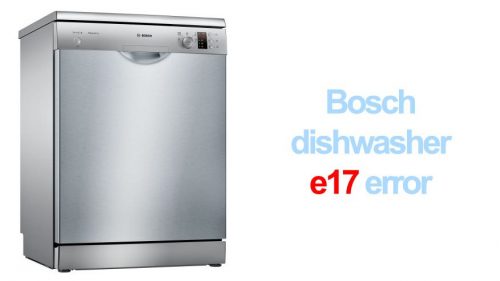The convenience of dishwashers is indisputable, streamlining the dish-cleaning process and liberating time for other pressing tasks. However, like any mechanical device, dishwashers such as those from Bosch can encounter hitches. A recurrent issue is the E17 error. This article will offer an in-depth view of the Bosch dishwasher E17 error, its probable triggers, and elaborate guidelines to resolve it.
Decoding the Bosch Dishwasher E17 Error
In a Bosch dishwasher, the E17 error points to a dilemma with the water supply. This error typically corresponds to an overfill condition, suggesting the dishwasher is inundated with more water than it can handle. This alert can hamper your dishwasher’s functionality, resulting in unsatisfactory cleaning outcomes or even possible water-related damage.
Probable Sources of the E17 Error
Identifying potential sources of the E17 error can aid in effective problem-solving. Here are some likely culprits:
- Compromised Aquastop Device: Bosch dishwashers boast an Aquastop component designed to avoid flooding. The device features a float switch that monitors water levels and a solenoid valve capable of terminating the water supply when required. If the Aquastop device is malfunctioning, it could misread the water level, triggering the E17 error.
- Inlet Valve Malfunction: The inlet valve regulates the volume of water permeating the dishwasher. If it’s defective or compromised, it might permit an excessive volume of water into the device, thus causing the E17 error.
- Obstructed or Defective Pressure Switch: The pressure switch is responsible for detecting the water level in the dishwasher. If it’s blocked or faulty, it might fail to accurately gauge the water level, leading to an overflow and subsequently, the E17 error.
Identifying and Rectifying the E17 Error
When dealing with the Bosch dishwasher E17 error, problem identification and resolution should be systematic. Below is a methodical guide to assist you:
- Power Off: The first step is to ensure the dishwasher is not connected to the power supply. This is a critical safety measure to avoid electric shock during the problem-solving process.
- Inspect the Inlet Valve: Identify the location of the inlet valve and inspect it for any obvious damage. If you infer that the valve might be permitting an excessive amount of water into the device, a replacement might be necessary. Your dishwasher’s manual can provide instructions on accessing and replacing the inlet valve.
- Scrutinize the Aquastop Device: Check the Aquastop device for any visible indications of damage. If it’s malfunctioning, a replacement will be necessary.
- Verify the Pressure Switch: Locate the pressure switch and inspect it for any obstructions or defects. Clean it if needed, or replace it if it’s not operating correctly.
- Reach Out to a Professional: If the E17 error persists after all the above steps, it’s advisable to seek help from a professional repair service. The problem could be more intricate than a simple part replacement and might require a more profound examination.
Maintenance to Evade the E17 Error
Proactive maintenance can significantly help in circumventing problems like the E17 error. Regularly scrutinize the Aquastop device, inlet valve, and pressure switch for potential issues. Also, consider a professional maintenance service for your Bosch dishwasher periodically. These measures can ensure the dishwasher’s peak performance and save you from unnecessary stress and expensive repairs.
To sum up, the E17 error in a Bosch dishwasher, while troublesome, can be mitigated by understanding the problem, its triggers, and the steps to resolve it. Safety is paramount; if you’re uncertain about any step, professional help should be your go-to. Maintain your Bosch dishwasher’s peak performance, and continue relishing the advantages of an effortless dishwashing process.

